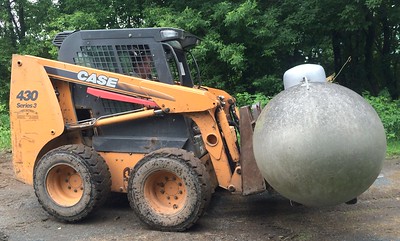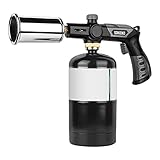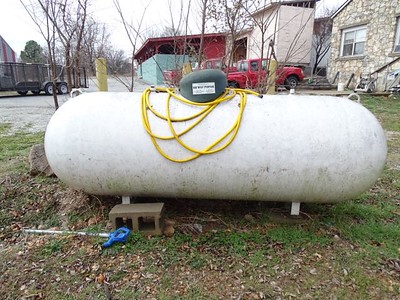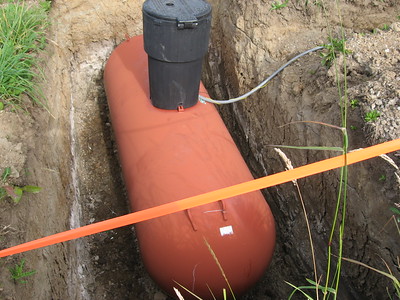
Moving a 250-gallon propane tank can be a daunting task, but it is important to do it safely and efficiently. Whether you are relocating the tank to a new location, or simply need to move it for maintenance or repair, there are several ways to do it. Here, we will discuss some of the most common methods used for moving a 250-gallon propane tank.
- Use a Specialized Propane Tank Dolly
One of the easiest and safest ways to move a propane tank is to use a specialized propane tank dolly. These devices are specifically designed for moving propane tanks, and typically have wheels and a handle for easy maneuverability. The tank can be easily rolled onto the dolly and then moved to the desired location. Many propane tank dollies are also equipped with straps or other devices to secure the tank in place and prevent it from falling off during transport.
- Use a Forklift
Another common method of moving a propane tank is to use a forklift. If the propane tank is equipped with a set of forklift pockets, it can be moved with a forklift. This is a safe and efficient method of moving large propane tanks, as the forklift can easily lift and move the tank to the desired location. However, it is important to make sure that the forklift is rated for the weight of the propane tank and that the operator is properly trained in the use of the forklift.
- Hire a Professional Moving Company
Another option for moving a 250-gallon propane tank is to hire a professional moving company. Some moving companies have experience and equipment specifically designed to move propane tanks. They will have all necessary equipment, like dollies, straps, and even cranes, to safely move the tank to the new location. Hiring a professional moving company can also give peace of mind that tank is handled by experienced team and you don’t have to worry about any damage, liability or safety hazards.
- Use a Crane
If the propane tank is too heavy to be moved by hand or with a forklift, a crane can be used to lift and move it. This method is often used for very large propane tanks and involves using a crane to lift the tank and move it to the desired location. This is a safe and efficient method of moving propane tanks, but it requires specialized equipment and trained personnel to operate.
- Towing a Trailer
Towing a trailer can also be used to move a 250-gallon propane tank. A flatbed or lowboy trailer can be used to move the tank, with straps or other devices to secure it in place. This method is also widely used, but requires a vehicle that is rated for the weight of the propane tank, and the driver should be trained and experienced in towing.
It’s important to note that transporting a propane tank is a task that should be carried out by experienced and well-trained professionals, since even the slightest mistake can have severe consequences. Make sure to check all rules, regulations and laws regarding transport of propane tanks and check the integrity of the tank before moving it. Don’t forget to also check on the fill level and pressure of the tank before transport, to avoid any accidents.
 |      |      |      |
When Moving a 250 Gallon Propane Tank, Consider Its Weight to Be Safe
When moving a 250 gallon propane tank, it is important to consider its weight. The tank itself can weigh up to 480 pounds when empty and 1,350 pounds when full, so it is important to have enough help to move it safely. If the tank is not properly secured, it could easily tip over and cause serious injury or damage. Make sure to use proper lifting te| you can safely move your propane tank without incident.
Make sure that you have enough people to help you move the tank, and that everyone knows what they are doing. If possible, use a dolly or other similar device to help with the move. Be careful when lifting the tank and setting it down. If it falls or tips over, it could cause serious damage or even an explosion. Propane is odorless, so you will not be able to smell if there is a leak. If you think there may be a leak, evacuate the area immediately and call your local fire department.
Consider Removing the Propane Before Moving the Tank
If you’re planning on moving a 250 gallon propane tank, you should consider removing the propane before doing so. This will make the process much safer and easier, and will prevent any accidents from happening.
Propane is a highly combustible gas, so it’s important to be very careful when handling it. If you’re not experienced in working with propane, it’s best to leave the job to a professional.
When you remove the propane from the tank, you’ll need to vent the tank properly. This can be done by opening the valve at the top of the tank and letting the gas escape until the pressure inside is equalized.
Once the propane has been removed, you can then safely move the tank to its new location. Be sure to follow all safety precautions when handling and transporting propane tanks, and always consult with a professional if you’re unsure about anything.
Pre-move Preparations
Ensuring the safety and integrity of a propane tank before its move is crucial. Proper preparations can significantly reduce the risk of accidents and simplify the moving process. Here are the recommended steps for getting a 250-gallon propane tank ready for transport:
1. Inspect the Tank
Before attempting to relocate the tank, a comprehensive inspection should be conducted. This can help identify any conditions that may make the move more challenging or risky.
Identifying Potential Weak Spots or Damages:
- Examine the body of the tank, looking specifically for dents, scratches, or deformations.
- Check the base and supports. Over time, these areas can weaken or get damaged due to the weight of the tank.
- Assess the valve and connecting areas, ensuring there are no visible cracks or breaks.
Checking for Rust, Corrosion, or Leaks:
- Surface rust can be a sign of more severe corrosion underneath. If rust is flaking or chipping away, it might be compromising the tank’s integrity.
- A soapy water solution can be used to detect leaks. Apply it to the valves and connectors, and look for bubbles, which would indicate escaping gas.
2. Determine Propane Level
Knowing how much propane is in the tank can help make informed decisions about its relocation.
Using a Tank Gauge:
- Most propane tanks are equipped with a gauge. If one isn’t present, it might be beneficial to invest in one.
- Ensure the gauge is read correctly; sometimes, temperature fluctuations can affect the reading.
Reasons to Move with Minimal Propane:
- A less-filled tank is lighter, making it easier and safer for transport.
- In the event of an accident or leak, a tank with minimal propane presents a smaller hazard.
3. Safety Gear & Equipment
The right equipment can make the task more manageable and drastically reduce the risk of injury or accidents.
Specific Protective Equipment:
- Specialized Gloves: These provide a good grip and protect against potential cold burns from the propane.
- Safety Goggles: They shield the eyes from potential propane splashes and protect against debris during the move.
Specialized Moving Equipment:
- Tank Dollies or Cradles: Designed to help move large and heavy tanks with minimal effort. Ensure they are rated for the weight of a 250-gallon propane tank.
- Other equipment like lifting straps or jacks might be necessary if there’s a need to elevate the tank.
By following these pre-move preparation steps, a smoother transition of the propane tank to its new location is ensured. Always prioritize safety, and consider seeking professional assistance if any part of the process seems challenging.
Disconnecting & Securing the Tank
The process of disconnecting a 250-gallon propane tank from its current setup is critical to ensure safety. Once disconnected, the tank needs to be secured appropriately for transport. Here’s a detailed guide for both actions:
1. Properly Shut Off the Valve
It’s vital to ensure the tank’s valve is fully closed to prevent any unintentional gas leaks.
Step-by-step Guide:
1. Locate the main valve on the top of the propane tank. It’s usually marked and is where the gas line connects.
2. Turn the valve clockwise (right) until it comes to a complete stop. Do not force it further once it’s fully closed.
3. Double-check by trying to turn it counter-clockwise (left) slightly. If it doesn’t budge, it’s shut correctly.
2. Disconnecting from Appliances
The tank may be connected to various appliances. Disconnecting it safely is paramount.
Procedure:
1. Ensure all connected appliances are turned off.
2. Using an appropriate wrench, slowly disconnect the gas line from the appliance.
3. Once disconnected, cap or cover the open end of the gas line to prevent debris entry and minimize leak risks
3. Purging Remaining Gas
Purging ensures that any residual gas in the lines or tank is removed, reducing flammability and risk during transit.
Importance:
- Even small amounts of residual gas can pose a risk, especially in closed spaces like transport vehicles.
Purging helps in reducing pressure within the tank, making it safer for transport.
Methods and Precautions:
- Attach a propane-approved purging valve to the tank’s service valve.
- Open the purging valve slowly, allowing gas to escape. A hissing sound indicates the gas is being released.
- Once the hissing stops, close the purging valve.
- Ensure this process is done in a well-ventilated area, away from open flames or ignition sources.
4. Securing for Transit
A propane tank, especially one of 250 gallons, can be a hazard if not properly secured during transport.
Use of Specialized Straps or Harnesses:
- Industrial-grade straps or harnesses should be used to fasten the tank in place. Ensure they are rated for the weight of the tank.
- They should be tightened to ensure the tank doesn’t shift but not so tight that they cause deformation or damage to the tank.
Upright Position:
- Always transport the tank in an upright position. This ensures that the safety valves function correctly and reduces the risk of leaks.
- If the tank has to be tilted for any reason, it should never be more than 45 degrees from upright, and it should be returned to an upright position as soon as possible.
Ensuring a propane tank is properly disconnected and secured for transit is a crucial safety measure. It’s always wise to consult or hire professionals when uncertain about any steps in this process.
Unloading & Reconnecting
Relocating a 250-gallon propane tank is a significant task, and once it’s transported, the final steps of unloading and reconnecting are crucial. Here’s a simple guide for these procedures:
1. Choosing an Ideal Location
Finding the right spot for your propane tank ensures long-term safety and accessibility.
Criteria:
- Flat and stable ground to prevent the tank from tipping.
- Good ventilation, away from open flames or potential ignition sources.
- Easily accessible for refills but away from areas with a lot of foot traffic.
2. Unloading Techniques
To safely get the tank off the vehicle and avoid any potential damage:
Steps:
1. Park on level ground.
2. If using a dolly, position it near the tank. With help, gently move the tank onto the dolly.
3. Ensure the tank remains upright during the entire unloading process. Roll it gently to its new location.
3. Reconnecting to Appliances
Reconnection should be done meticulously to ensure a safe gas flow.
Guidelines:
- Before starting, make sure all linked appliances are off.
- Attach the gas line to the tank, securing it tightly using appropriate tools.
- After reconnecting, double-check the connections to ensure there aren’t any gas leaks.
Setting up your propane tank at its new location requires careful attention to detail. If you’re unsure about any steps, always consider seeking the advice or services of a professional.
Post-Move Inspection
After relocating your propane tank, a post-move inspection is vital to ensure its safety and functionality.
Assessing for Damage or Distress:
- Inspect the tank’s exterior closely for any dents, scratches, or signs of wear that might have occurred during the move. Ensure the tank’s base and supports are stable and undamaged. Also, be on the lookout for any discoloration or rust that might indicate potential issues.
Checking Connections and Leaks:
- All connections should be secure and tightly fastened. To check for leaks, you can apply a soapy water solution around the connections; forming bubbles indicate a possible leak which needs attention.
Functionality of Gauge and Valves:
- Check the tank’s gauge to make sure it provides an accurate reading. The tank’s valves should also be manually tested to make sure they open and close smoothly without any resistance.
Consider Hiring a Professional
There are a few things to consider when you’re thinking about whether or not to hire a professional to help you move your 250 gallon propane tank. For one, propane is highly flammable, so it’s important to be extra careful when handling it.
Additionally, a full tank can weigh up to 1,000 pounds, so it’s not something you want to try to move on your own unless you’re absolutely sure you can do it safely. If you decide to hire a professional to help you move your propane tank, make sure you find someone who is experienced and has the proper equipment to do the job safely. Moving a propane tank is not something you want to leave to chance, so it’s worth spending the money to have it done right. The installation fees of the tank might be too expensive, please be aware of this as well.
Conclusion
Moving a 250-gallon propane tank is no small feat, and safety should always be at the forefront of this endeavor. It’s crucial to recognize the potential risks involved and to be meticulous in every step, from pre-move preparations to post-move inspections. While the guidelines provided offer insights into the process, it’s essential to understand that each situation can have its unique challenges.
If at any point you’re uncertain or feel uncomfortable about any aspect of the move, don’t hesitate to seek professional assistance. Propane experts are equipped with the knowledge and tools necessary to ensure the safe transport and setup of such a substantial tank. Remember, when dealing with propane, it’s always better to be safe than sorry.


Mike is an experienced propane technician with over 15 years of professional experience in the field. He has dedicated his career to helping customers with their propane needs, from installation to maintenance and repair. Together with Jeremy, he co-founded this website to provide useful information and guidance to customers seeking reliable propane services.







